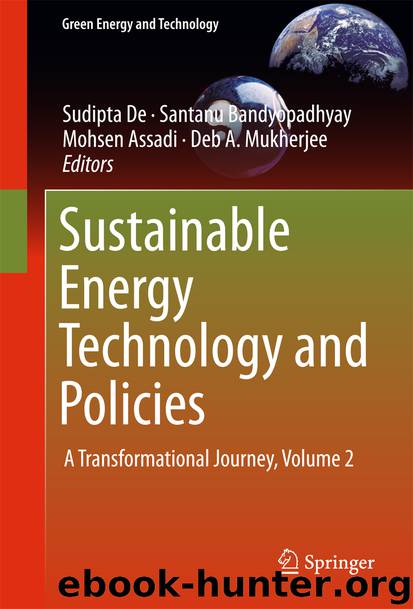Sustainable Energy Technology and Policies by Sudipta De Santanu Bandyopadhyay Mohsen Assadi & Deb A. Mukherjee

Author:Sudipta De, Santanu Bandyopadhyay, Mohsen Assadi & Deb A. Mukherjee
Language: eng
Format: epub
Publisher: Springer Singapore, Singapore
3 Government Response
By investing heavily in solar and wind, Indian government has helped drive down the cost of those technologies to a point where, in many places, renewable sources can generate electricity more cheaply than sources of energy like coal. The shift from fossil fuels has thus been much faster and more pronounced than most experts expected. Indian officials have estimated that country might no longer need to build new coal plants beyond those that are already under construction.
India has the world’s fourth largest wind power market10 and also plans to add about 100 GW of solar power capacity by 202011 as announced in the national solar mission. In fact, this year India will likely overtake Japan as the world’s third-largest solar-power producer, after China and the US. This is ensuring that our dependency on coal plants is decreasing. India also foresees an increase in the contribution of nuclear power to overall electricity generation capacity which is one of the highest energy guzzlers from 4.2 to 9% within 25 years12 according to the government plans. The country has five nuclear reactors under construction and plans to construct 18 additional nuclear reactors by 2025.13 These commitments showcase the importance given by the government in response to the energy requirement.
On the electricity front, the country has developed an Energy Efficiency Code for Buildings and has launched one of the biggest effort worldwide for LED’s to replace bulbs at affordable prices for consumers. According to the manufacturer’s association till a couple of years ago less than 5 million LED lights were being used in the country, they estimate that now more than 100 million have been put to use. Even this is small because the manufacturers see the investments multiplying 24 times from the current level in less than 5 years to cater to the demand.14 Though the vast majority of India’s electricity needs still comes from heavily-polluting coal power plants, just under two thirds of its total capacity, but India is aiming for a target of 40% renewable energy.15
In a recent auction in India, developers of solar farms offered to sell electricity to the grid for INR 2.44 rupees per kilowatt-hour.16 That is about 50% less than what solar farms bid a year earlier and about 24% less than the average price for energy generated by coal-fired power plants.17 Solar electricity price is going to become the benchmark price for deciding the other fuel prices (Petroleum products, LNG, CNG, LPG, coal, lignite, biomass, etc.) based on their ultimate use and advantages.
In all major energy intensive sectors—steel, aluminium, fertiliser, paper, cement—levels of energy efficiency in India are at global levels. The need for energy efficient products is also triggering innovation. The product portfolios of organizations are helping consumers become energy efficient with new energy efficient products accounting for a large and growing part of their revenue portfolio. Once upon a time there was a song that went “Video killed the Radio Star”; there can be a hundred songs like that now because energy efficiency is triggering innovation.
Download
This site does not store any files on its server. We only index and link to content provided by other sites. Please contact the content providers to delete copyright contents if any and email us, we'll remove relevant links or contents immediately.
Life 3.0: Being Human in the Age of Artificial Intelligence by Tegmark Max(5200)
The Sports Rules Book by Human Kinetics(4087)
The Age of Surveillance Capitalism by Shoshana Zuboff(4001)
ACT Math For Dummies by Zegarelli Mark(3859)
Blood, Sweat, and Pixels by Jason Schreier(3502)
Unlabel: Selling You Without Selling Out by Marc Ecko(3478)
Hidden Persuasion: 33 psychological influence techniques in advertising by Marc Andrews & Matthijs van Leeuwen & Rick van Baaren(3307)
Urban Outlaw by Magnus Walker(3251)
The Pixar Touch by David A. Price(3226)
Bad Pharma by Ben Goldacre(3113)
Project Animal Farm: An Accidental Journey into the Secret World of Farming and the Truth About Our Food by Sonia Faruqi(3030)
Brotopia by Emily Chang(2904)
Kitchen confidential by Anthony Bourdain(2844)
Slugfest by Reed Tucker(2809)
The Content Trap by Bharat Anand(2786)
The Airbnb Story by Leigh Gallagher(2711)
Coffee for One by KJ Fallon(2437)
Smuggler's Cove: Exotic Cocktails, Rum, and the Cult of Tiki by Martin Cate & Rebecca Cate(2347)
Beer is proof God loves us by Charles W. Bamforth(2260)
